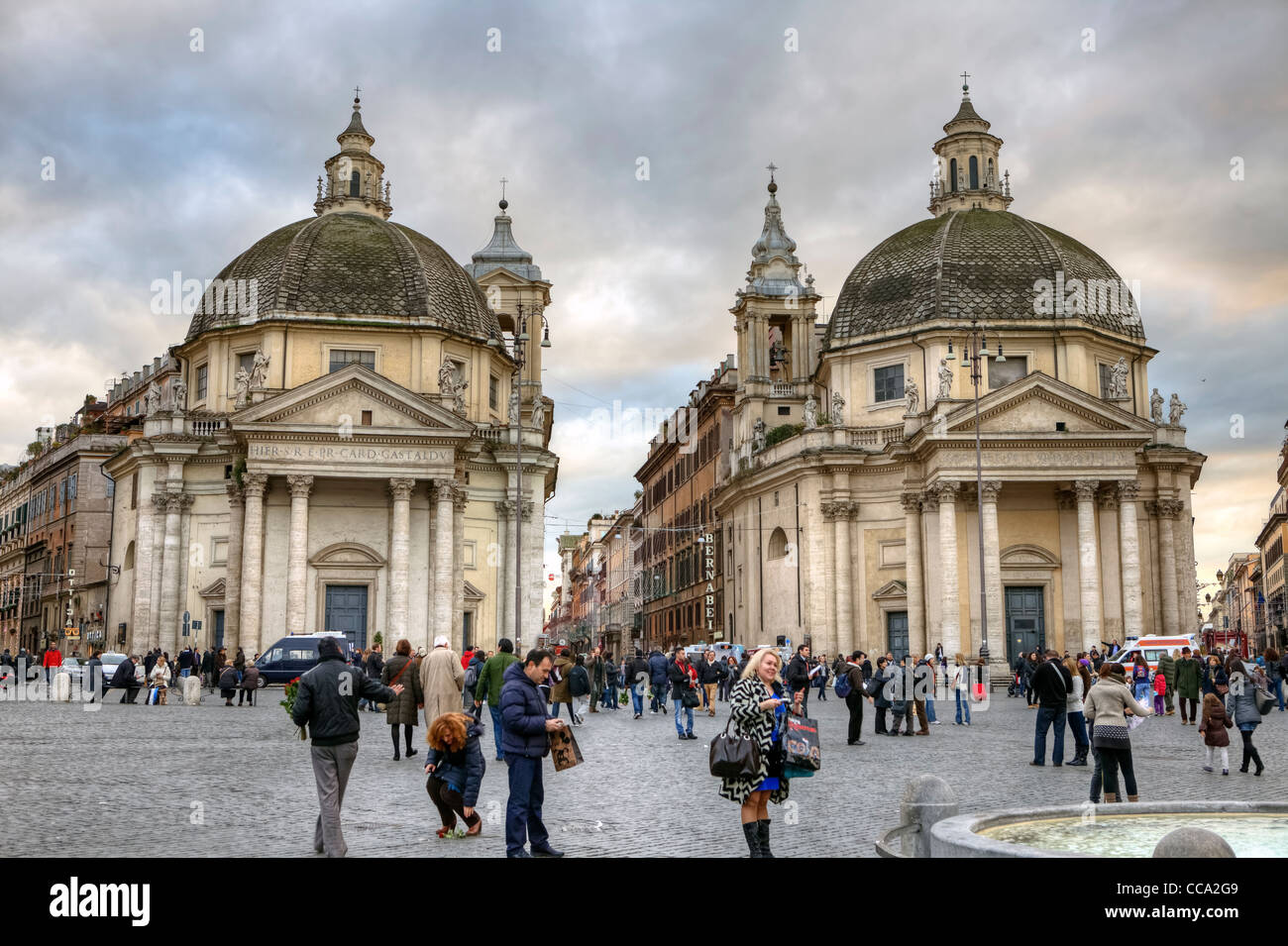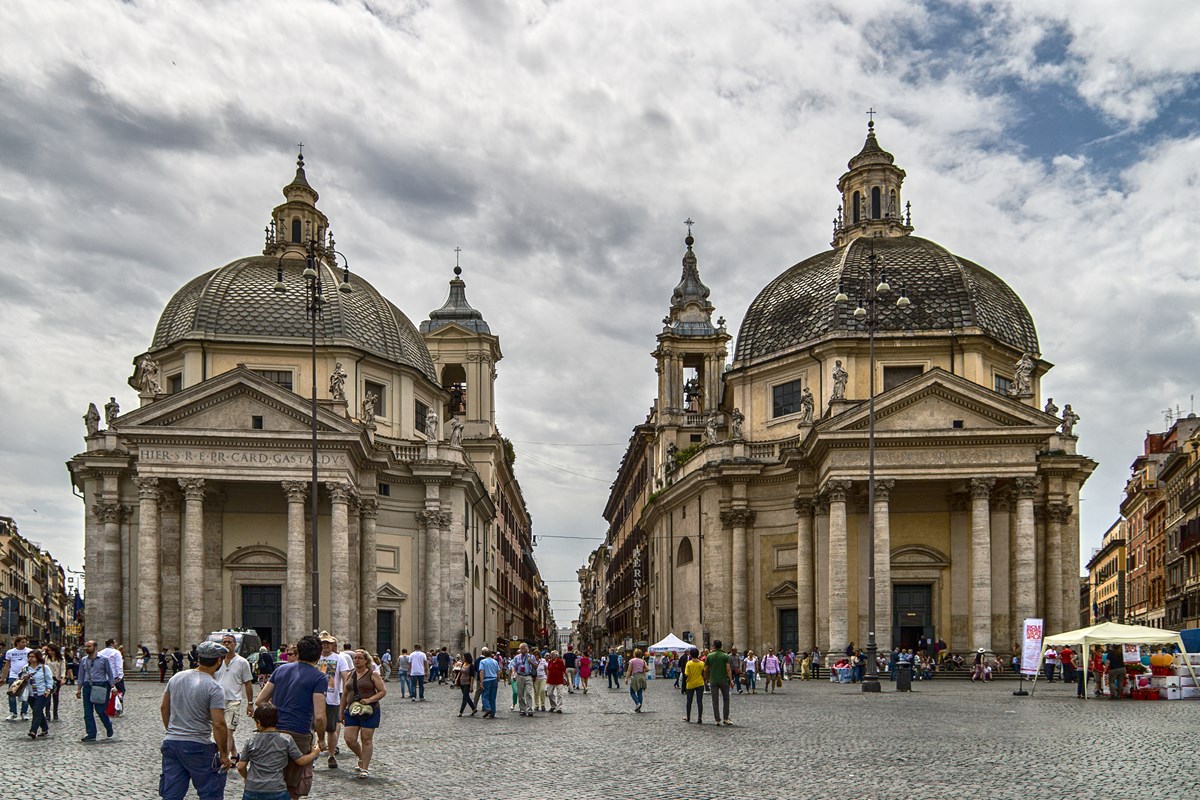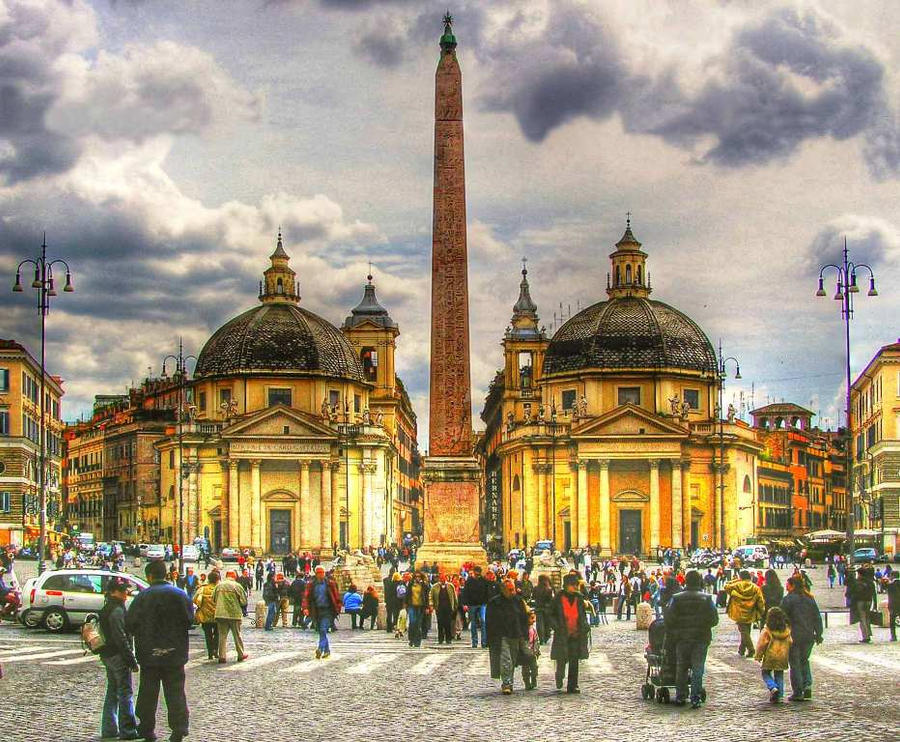Twin Churches on a Famous Square in Rome Editorial Stock Photo Image

Piazza del Popolo twin churches, Rome The Piazza lies in… Flickr
One-half of the famous twin churches of Piazza del Popolo, Santa Maria dei Miracoli, is a 17th-century Carlo Rainaldi design built to help make an especially dramatic entryway for Via del Corso. An example of the ideal of symmetry in Baroque architecture, the church is typical for the era.

rome twin churches. the twin churches of santa maria di mo… Flickr
The twin churches at the far end of Piazza del Popolo, which Valadier had incorporated into his plans, had been constructed well over a century earlier. Though initiated by Carlo Rainaldi, they were completed by Gian Lorenzo Bernini with the collaboration of Carlo Fontana.Rainaldi invested the best of his abilities into the design and construction of Santa Maria dei Miracoli.

Piazza del Popolo in Rome, Lazio, Italy with the twin churches of Santa
The "twin" churches of Santa Maria di Montesanto (left) and Santa Maria dei Miracoli (right), seen from Piazza del Popolo. Between the two churches Via del Corso starts. Although very similar, differences can be seen in this image in the two small belfries and in the two domes (noticeable from the number of windows in the tympanum of each church).

The Twin Churches. Piazza Del Popolo . Rome. Italy Editorial Stock
Located in Piazza del Popolo between Via del Corso and Via di Ripetta, north of the ancient Campo Marzio, the church of Santa Maria dei Miracoli is one of the "twin" churches, together with Santa Maria in Montesanto. Its construction comes from a legend that tells of a miracle that occurred on the banks of the Tiber.
View of the Twin Churches, Piazza Del Popolo, Rome, Italy Editorial
The Minims, officially known as the Order of Minims (O.M.), is a monastic order within the Roman Catholic Church that emphasizes a life of humility and austerity. In the case of Trinità dei Monti, King Louis XII of France sponsored the church's construction in the early 16th century.

The Twin Churches of Rome
The church's appearance itself is "standard" for Italy--art from the 16th century to current. For a parish church, it seems to have unusual outreach and services in different languages. What is interesting--I could find out nothing about it--is the bell tower (campanile), which has different peals and tunes at different times on different days..

Twin Churches in Rome with Italian Flag Stock Photo Image of rome
The Twin Churches of Rome Tours POPULAR EXCURSIONS Rome Tourist Card Rome Tourist Card Snap up the Rome Tourist Card and you'll get everything you need to explore Rome's top highlights including Colosseum, Palatine Hill, Roman Forum and Hop on/off bus. You can even choose the order you see things in. from: € 82,00 Book now

Twin Churches on a Famous Square in Rome Editorial Stock Photo Image
The Twin Churches, located in Rome, Italy, are a stunning example of Baroque architecture and are renowned for their grandeur and beauty. These churches, also known as the "Chiese dei Santi Vincenzo e Anastasio" in Italian, are situated in the heart of the city, near the Piazza del Popolo.

Rome, Italy May 30, 2018 Church Santa Maria Dei Miracoli One of
The twin churches (the chiese gemelle) of Santa Maria dei Miracoli (1681) and Santa Maria in Montesanto (1679), begun by Carlo Rainaldi and completed by Bernini and Carlo Fontana, define the junctions of the roads.

The 'Twin' Churches of Santa Maria in Montesanto & Santa Maria dei
The famous twin churches of Piazza del Popolo: we discover 3 curiosities concerning two of the most famous buildings of worship in Rome.

Twin Churches, Piazza Del Popolo, Rome, Italy Stock Image Image of
Piazza del Popolo is one of the most famous and most beautiful squares in Rome. It is a large elliptical space designed by architect Valadier, with several interesting churches, an impressive obelisk, three fountains and the old and impressive city gate into Rome: Porta del Popolo. The square is wonderful.

Twin churches, Rome, Italy stock photo. Image of domes 47427030
It might seem only natural to imagine that the Church in Rome, being Greek in origin, would have needed time to become familiar with the symbols of the capital; that once it adopted Latin it would almost inadvertently begin to share in Roman tastes and manners; and that soon it would take the government of the Empire as its model, in the hope of tempering sanctity with power.

Twin Churches, Rome by pimslabs on DeviantArt
The 'Twin' Churches 4/5/2019 Map The 'Twin' Churches of Santa Maria in Montesanto & Santa Maria dei Miracoli Santa Maria in Montesanto and Santa Maria dei Miracoli, the two Baroque churches which stand on the south side of Piazza del Popolo, are often referred to as the chiese gemelle (twin churches).

Twin Churches, Piazza del Popolo, Rome, Italy Best viewed … Flickr
by Violeta Matei The three churches where you can find paintings by Caravaggio in Rome are Sant' Agostino, San Luigi dei Francesi and Santa Maria Di Popolo. Find out how to visit all three churches in a self-guided tour of historic Rome. The entrance is free, but lighting up the artworks requires inserting Euro coins into a box.

Rome Twin churches stock image. Image of stone, campanile 108409315
From the Baroque period to the present day. In the 17 th century, Pope Alexander VII tasked the great Roman Baroque artist Bernini with decorating the interior facade of Porta del Popolo. The 'twin' churches of Santa Maria dei Miracoli and Santa Maria in Montesanto were designed first by Carlo Rainaldi before Bernini reviewed the plans, and the project was eventually completed by Carlo.

"Twin Churches, Rome, Italy" by Alison Brown Redbubble
Santa Maria dei Miracoli is one of the twin 17th century churches on the Piazza del Popolo, the other being Santa Maria in Montesanto (they are often treated together in the literature). The address of this one is Via del Corso 528, and the rione is Campo Marzio. Pictures of the church on Wikimedia Commons are here. There is an English Wikipedia article, shared with its twin, here. The.